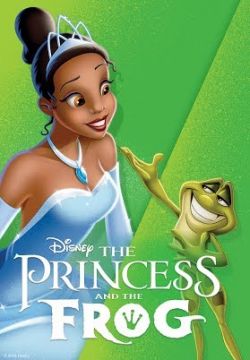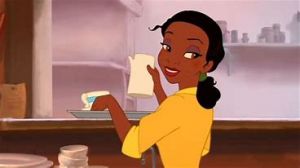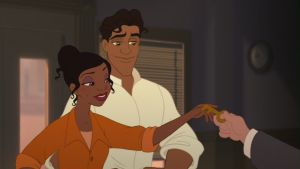The Princess and the Frog
The Princess and the Frog is a Disney animated movie produced in 2009. The movie is based on the novel The Frog Princess written by Elizabeth Dawson Baker in 2002. According to Wikipedia, the film "received largely positive reviews from critics and audiences, praising the animation (particularly the revival of the medium), characters, music, and themes, and was also successful at the box office, ranking first place on its opening weekend in North America, and grossing around $270 million worldwide becoming Disney’s most successful traditionally animated film since Lilo & Stitch in 2002. It also got three Oscar nominations at the 82nd Academy Awards: one for Best Animated Feature and two for its achievement in music (Original Song). It lost to Up and Crazy Heart, respectively"[1]. Even so, the movie caught the attention of people regarding the racism that it contains.
Plot
Set during the 1920s located in New Orleans, the film tells the story of a dedicated server named Tiana who had a dream of opening her own restaurant. Soon after kissing a sovereign who has been transformed into a frog by a voodoo alchemist, Tiana turns into a frog herself and must figure out how to turn around into a human before it is past the point of no return.
Controversy
Language
Disney film Princess and the Frog seemingly demonstrate the stereotypical views in characters through their language that they speak. Shawg Ahmed, from University of Colorado Boulder, pointed out that in this movie, "all the African American characters speak African American Vernacular English (AAVE), while the White American characters speak Standard American English (SAE)"[2]. All of the African American characters speak AAVE and depicted as working/poor class status as well as live in smaller houses. At the same time, they also work in service-based positions, like Tiara, who is a waiter in the movie.
It represents that AAVE speakers are laborers, that they are not smart enough or not having the potential to succeed in high-level occupations.
Characters
Tiana, who had a dream of opening and owning a restaurant, is told by the real estate brokers of her dream property that “a woman of her background” should not strive so high. Whereas "her background" here stands in for Tiana’s race as an underprivileged, dark-skinned, fatherless girl.
However, Tiana isn't the only problem, says Angela Bonner Helm at Black Voices. The other problem is that her love interest, Prince Naveen of Maldonia, is not black. Prince Naveen is ambiguously raced, having a slightly lighter skin color than Tiana. He also speaks in what seems like a French accent (noticed by his speaking in Spanish when he’s a frog). This problem creates questions from viewers. Why in the world of black people, even the prince cannot be black? This fact becomes an offense for black viewers.
Reference
- ↑ ""The Hurt Locker" Takes Top Honors at 82nd Academy Awards". playbill.com. Playbill. Retrieved February 1, 2015.
- ↑ https://www.colorado.edu/linguistics/2018/05/08/racial-stereotypes-my-childhood-film


